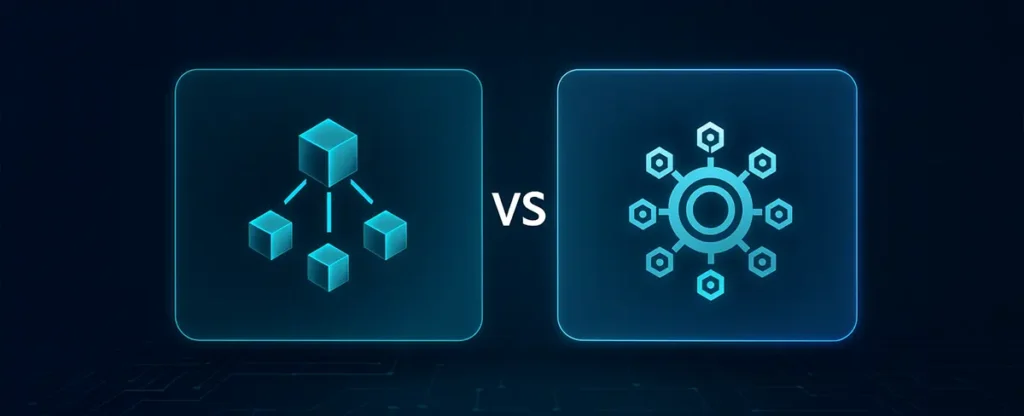
If you work in IT or cloud computing, you’ve probably heard people talk about SOA and microservices. These two terms are quite common when teams discuss how to build modern software that’s fast and easy to manage.
Both SOA and microservices aim to simplify how systems are built. Instead of putting everything into one big structure, they split it into smaller parts that work on their own. Each part has a clear purpose. When something needs to change or improve, developers can focus on that specific area without disturbing the rest of the system.
Even though SOA and microservices have the same goal, they are not exactly the same. Each works in a different way and has its own advantages. Understanding SOA vs microservices can help you make better choices for your software and avoid problems later on.
What is service oriented architecture?
Service-Oriented Architecture, or SOA, is a software design approach where different parts of an application communicate with each other through a network using standard protocols. Its main goal is to connect multiple services, so they work together smoothly, whether those services come from new applications or older systems. This model is especially useful for large organizations that need to bridge the gap between outdated technology and modern solutions.
Benefits of service-oriented architecture
Service-Oriented Architecture, or SOA, helps software systems work together more effectively. It’s built around small, independent parts that communicate through standard rules. This design makes it easier to manage, update, and expand software over time. The main benefits include reusability, interoperability, and scalability.
Reusability
With SOA, developers can reuse existing services instead of building new ones from scratch. This saves time and money while maintaining consistent quality. It also helps teams deliver new features and applications more quickly.
Interoperability
SOA allows different systems to connect and share information, even if they use different technologies or programming languages. This improves collaboration across teams and makes it easier for businesses to adopt new tools as they evolve.
Scalability
Because SOA is modular, each service can grow or adjust based on demand. When traffic increases, companies can scale only the parts that need it, keeping performance stable without unnecessary costs or major redesigns.
What are microservices?
Microservices architecture is considered the modern evolution of software design. In this approach, an application is built from many small, independent services that communicate with one another through APIs rather than relying on a single, traditional monolithic system.
Each service focuses on a specific function, making the overall structure more flexible and scalable. Microservices design patterns support faster development cycles and fit perfectly with agile practices used in modern software development.
Every microservice operates on its own, which makes continuous integration and deployment much easier. Teams can update or improve individual services without waiting on other parts of the system, creating a faster and more innovative development process.
Benefits of microservices
Microservices have become a popular choice for modern software development. They help businesses build flexible, fast, and reliable systems that can easily grow with changing needs.
Faster Development
Microservices enable teams to work on different parts of an application at the same time. This speeds up the overall software development process and helps deliver new features more quickly. Parallel development keeps projects moving fast and allows businesses to respond to market needs sooner.
Improved Scalability
Each service can be scaled individually based on demand. This means companies can allocate resources where they’re needed most, improving performance and reducing unnecessary costs. The ability to scale precisely makes systems more efficient and easier to manage.
Resilience
Because each microservice runs independently, a failure in one service doesn’t bring down the entire system. This makes modern applications more stable and reliable. A resilient system ensures users experience fewer disruptions and can continue using the service smoothly.
SOA vs Microservices: Key differences
Although SOA and microservices share similar goals, they differ in several important ways. The main distinction lies in their architectural style. SOA follows a top-down, centralized structure, whereas microservices use a bottom-up, decentralized approach.
| Feature | SOA | Microservices |
| Architectural style | Coarse-grained, centralized | Fine-grained, distributed system Decentralized data management |
| Service granularity | Larger, more comprehensive services | Smaller, focused services |
| Independence | Services are interdependent May share a database for data storage | Services are highly independent Decoupled and autonomous |
| Communication | Synchronous, often message-oriented Uses shared data | Asynchronous, often RESTful Avoids data sharing |
| Data storage | Centralized data management Services share database | Distributed (decentralized) data management Each service is responsible for its own data management |
| Scalability | Horizontal scaling Scaling specific services can be intricate due to shared resources and centralized communication | Horizontal and vertical scaling More granular and focused scaling as services operate independently |
| Deployment | Typically involves deploying the entire application as a single unit | Each service deploys and scales independently Facilitates continuous delivery |
| Coupling | Services exhibit a degree of coupling due to shared resources and centralized communication | Loose coupling with minimal dependencies between services |
Conclusion
A strong foundation is the key to lasting software. The structure of an application decides how well it performs, how easily it grows, and how smoothly teams can manage it. When architecture is planned with clarity, it supports progress instead of slowing it down.
Businesses today rely on systems that can handle change without losing balance. The way software is built affects everything from daily operations to long-term goals. A solid architectural plan gives stability while allowing space for improvement.
Xavor helps companies create systems that are reliable and easy to manage. Our team focuses on turning technical challenges into practical results that help businesses move forward with confidence.
For details or to start a conversation about your next project, contact [email protected].



